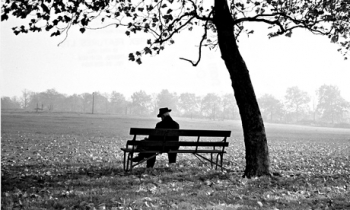“Here, take it!” I am looking at the arm of my elderly father, outstretched in my direction, a beautiful picture book in his hand. The aging, pale skin and freckles remind me of my Irish genes. My grumpy father is indicating that I should take the book and dispose of it somewhere—out of his room and life—in any way I choose. I cringe a little because the book was an expensive gift from an old friend who kindly spent the time and money to send it to him. It is a lovely coffee table book with nature photos from the American West, for which the loyal friend knows he has a fondness. Yet somehow, this gift does not measure up. My father’s impatience grows in that special way reserved for the elderly who, dissatisfied in their twilight opinions, abruptly voice their commands. This, is literal “give-back.”
FEATURES|THEMES|Health and Well-being
“Giving Back”—What is that Anyway?
Buddhistdoor Global | 2014-10-17 |
 In a world where everyone experiences some kind of suffering, from financial to emotional, giving and compassion become as vital as food and shelter. From Feri Lukas/Rex.
In a world where everyone experiences some kind of suffering, from financial to emotional, giving and compassion become as vital as food and shelter. From Feri Lukas/Rex.I shuffle around his room tidying up a life that is long in abundance and comfort and reflecting on the many times that he gave to others. Have you ever stopped to think about this notion of “giving back,” which the media seems to spin into tornadoes of altruistic hype, championing efforts of generosity? Is it only for public show, or does the issue resonate with heartfelt connection too? While the term sounds like some trendy thing to do, the question lingers with me about sincere intention.
We have a family tradition in that, on birthdays and special occasions, we gift “recycled” things as presents. We each have a lifestyle of material accumulation, and we basically have too much. So, rather than buy new presents for each celebration, we approach the gift-giving challenge with creative flair and a sense of fun. It becomes a treasure hunt to find an interesting item at home to suit the occasion and the recipient: a favorite book to pass along, a colorful scarf that would look better on another wearer, a box of old photos, perhaps some tea to try. Thought and care go into the selection, to engender a laugh, a memory, or simple pleasure for another. None of us needs “more stuff,” so our version of “giving back” is to recycle onwards. This can turn giving back into something playful and enjoyable.
Of course, this practice is not without the occasional hiccup. Some years ago, my sister initiated this gift-recycling system with her staff. One time, a previously new gift ended up being returned to the original giver a couple of seasons later. Whoops! The fun became tinged with emotional upset . . . definitely not the intention of the giver or the spirit of the mission!
There is another style of sharing that stems from a different intent. Many years ago, during a “poor-years” phase of my young adulthood, the parents of a dear friend took me in to live in their home. While I commuted to my job, they fed and sheltered me until my financial feet were back on the ground. When it came time to fly on my own, I asked my friend’s father what I could do for them in return for their kindness and generosity. The simple answer was: “Don’t give back anything to us, for one day it will be your turn to give to another. Help them next.” The depth of his words sank into my being. I can still see the love in his expression, and the selfless quality of his gesture still brings tears to my eyes. The intent was simple and clear: he expected nothing in return. That is the essence that I learned to carry in my heart in “giving back”—to give onwards to others without expectation of return.
Earlier this year, I attended an inspiring talk given at The University of Hong Kong by a rather modest and shy visiting monk named Venerable Dhammadipa. He spoke about cultivating positive feelings, and his teachings emphasized training in virtue and practicing to benefit all sentient beings. When a member of the audience asked what a person could do to help make the world a better place, he responded that we should cultivate love, compassion, joy, and equanimity to help improve our relations both near and far, and suggested four practices to develop positive feelings and harmony in the world: 1) Giving, or charity; 2) Kind speech; 3) Regarding oneself and others as the same; and 4) Beneficial activity.
In truth, each of these practices is a great undertaking in its own right, worthy of contemplation and wholesome effort. This could be as simple as offering a smile to a stranger—a humble gesture that may be just as powerful as something grand. How can each of us contribute in our own special way to “giving back,” in order to make this world a better place?
In truth, each of these practices is a great undertaking in its own right, worthy of contemplation and wholesome effort. This could be as simple as offering a smile to a stranger—a humble gesture that may be just as powerful as something grand. How can each of us contribute in our own special way to “giving back,” in order to make this world a better place?

Categories:
Comments:
Share your thoughts:













